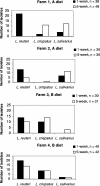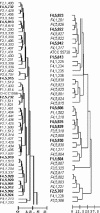Identification of the most abundant lactobacillus species in the crop of 1- and 5-week-old broiler chickens
- PMID: 17933935
- PMCID: PMC2168157
- DOI: 10.1128/AEM.01128-07
Identification of the most abundant lactobacillus species in the crop of 1- and 5-week-old broiler chickens
Abstract
Bacteria from crops of 1- and 5-week-old broiler chickens fed with two brands (diets A and B) of wheat-based diets were isolated on Lactobacillus-selective medium and identified (n = 300) based on partial 16S rRNA gene sequence. The most abundant Lactobacillus species were L. reuteri (33%), L. crispatus (18.7%), and L. salivarius (13.3%). Regardless of farm and feed, L. reuteri was the most abundant species (P < 0.005) in the crops of the younger chickens. However, the amount of L. reuteri was significantly reduced in the crops of the 5-week-old chickens regardless of the feed (P = 0.016). The diversity of L. reuteri isolates was studied by fatty acid analysis, and the 94 L. reuteri isolates could be arranged into several clusters. The nisin sensitivities of the L. reuteri isolates were determined because nisin is a candidate coccidiostat. Sensitive isolates were found more frequently in younger chickens (77%) than in 5-week-old chickens (23%), whereas chickens fed with commercial feed B had a higher proportion of nisin-resistant isolates (73%) than did chickens fed with feed A (45%). Nisin-resistant strains are potential candidates for adjunct cultures for maintaining L. reuteri in its natural niche in the crop and are potential targets for genetic engineering with nisin-selectable food-grade vectors. The diversity of the L. reuteri population suggested that one should consider including several strains representing different clusters and nisin resistance phenotypes in candidate probiotic feed supplements for chickens.
Figures



References
-
- Apajalahti, J. H., A. Kettunen, and H. Graham. 2004. Characteristics of the gastrointestinal microbial communities, with special reference to the chicken. Worlds Poult. Sci. J. 60:223-232.
-
- Axelsson, L., T. C. Chung, W. J. Dobrogosz, and E. Lindgrens. 1989. Production of a broad spectrum antimicrobial substance by Lactobacillus reuteri. Microbiol. Ecol. Health Dis. 2:131-136.
-
- Boling, S. D., J. L. Snow, C. M. Parsons, and D. H. Baker. 2001. The effect of citric acid on the calcium and phosphorus requirements of chicks fed cornsoyabean meal diets. Poult. Sci. 80:783-788. - PubMed
Publication types
MeSH terms
Substances
LinkOut - more resources
Full Text Sources
Molecular Biology Databases

